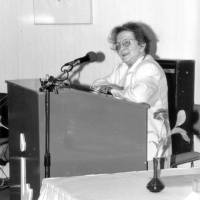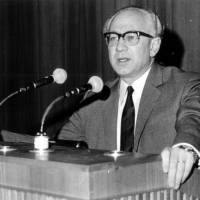Über die Stiftung
Die Shaul B. und Hilde Robinsohn Stiftung
Die Shaul und Hilde Robinsohn Stiftung wurde durch eine letztwillige Verfügung der Stifterin, Dr. Hilde Robinsohn, 1995 gegründet. Zweck der selbständigen und gemeinnützigen Stiftung ist es, in Fortführung des Werkes von Prof. Dr. Shaul B. Robinsohn die Forschungs- und Entwicklungsarbeiten der Internationalen Akademie Berlin gGmbH (INA), gegründet an der Freien Universität Berlin, auf den Gebieten der Curriculumforschung und -entwicklung, der Lehrer- und Erzieherbildung sowie der Vergleichenden Erziehungswissenschaft zu fördern, das Archiv und die Bibliothek Robinsohns zu pflegen und zu erhalten sowie die Veröffentlichungen von Robinsohn zu verbreiten. Als Shaul B. Robinsohn in den frühen sechziger Jahren von Hellmut Becker ans Berliner Institut für Bildungsforschung in der Max-Planck Gesellschaft berufen wurde, näherten sich die "Two Decades of Non-Reform in West German Education" (so der Titel eines der wirksamen Aufsätze Robinsohns) ihrem Ende. Zuvor hatte die Restauration spärliche Reformversuche erstickt. Ein hochselektives Schulsystem war wiedererstanden. Die Lehrpläne verharrten jenseits der Erfordernisse von Gegenwart und Zukunft. Die Lehrerbildung war kaum an beruflichen Schlüsselproblemen, sondern einseitig an den Bezugsdisziplinen orientiert. Shaul B. Robinsohn, Enkel eines Rabbiners und Sohn eines Hebraisten und Schriftstellers, in Berlin und Breslau aufgewachsen, dem Holocaust entkommen kehrte aus Israel zunächst an das Hamburger UNESCO-Institut zurück, bevor er einer der Gründungsdirektoren am Berliner Institut für Bildungsforschung wurde. Robinsohn hat in die westdeutsche Bildungsreform der sechziger und siebziger Jahre drei entscheidende, bis heute fortwirkende Impulse eingebracht:
- Erstens hat er die bestehende Praxis einer fächerfixierten und lebensfernen Lehrplanentwicklung einer fundamentalen Kritik unterzogen. Sein Strukturkonzept der Curriculumrevision, das von der Analyse von wichtigen Lebens-situationen und der Bestimmung darauf beziehbarer Qualifikationen seinen Ausgang nimmt, stellte die Verhältnisse vom Kopf auf die Füße und rückte die Legitimierung des Curriculum in den Mittelpunkt.
- Zweitens: "Alle Lehrer sind Lehrer", mithin – so Robinsohn – zunächst einmal Pädagogen. Sie sind nicht die lediglich einem didaktischen Reduktionismus verpflichteten Vertreter von Bezugsdisziplinen. Robinsohn hat ein Modell der Lehrerbildung entworfen, das pädagogisch begründet ist und die konventionelle Trennung zwischen theoriegeleitetem Studium und berufspraktischer Vorbereitung durch einen durchdachten Wechsel zwischen theoretischer und praktischer Professionalisierung überwindet.
- Drittens gilt Robinsohn als wesentlicher Vertreter einer Vergleichenden Erziehungswissenschaft, die das Verständnis für die politischen, ökonomischen, sozialen und strukturellen Bedingungen einer Bildungsreform erweiterte und damit der anhaltenden Gefahr einer Provinzialisierung der westdeutschen Bildungsdebatte entgegenwirkte.
Shaul B. Robinsohn hat die deutsche Nachkriegsentwicklung mit einer zurückhaltenden, dem Prinzip Hoffnung verpflichteten Sympathie begleitet. Seine Frau, Dr. Hilde Robinsohn, geborene Keilson, hat – selbst eine erfolgreiche Anwältin in Wiedergutmachungsprozessen – ihn auf seinem bildungswissen-schaftlichen Weg begleitet. Sie war eine genaue und konstruktive Partnerin im wissenschaftlichen Dialog, der sich in drei Sprachen – dem Hebräischen, dem Deutschen und Englischen – vollzog. Sie hat seinen wissenschaftlichen Nachlass bis zu ihrem Tod betreut und die Pflege und Fortführung seines Werkes der Stiftung und der Internationalen Akademie anvertraut.
Die Robinsohn - Bibliothek wurde durch Zustiftungen erweitert. Sie steht mit etwa 3.000 Bänden Forschenden und Studierenden offen und ist über die Universitätsbibliothek der Freien Universität Berlin zugänglich.
The Shaul and Hilde Robinsohn Foundation was established in 1995 through the bequest of its founder, Dr. Hilde Robinsohn. The purpose of the independent and non-profit foundation is to continue the work of Prof. Dr. Shaul B. Robinsohn by promoting research and development at the International Academy Berlin gGmbH (INA), founded at the Free University of Berlin, in the field of curriculum research and development, the training of teachers and educators, and comparative education; moreover, the foundation exists in order to maintain Robinsohn's archive and library and to disseminate his publications. When Shaul B. Robinsohn was summoned to the Berlin Institute for Educational Research at the Max Planck Society in the early Sixties by Hellmut Becker, "Two Decades of Non-Reform in West German Education" (the title of one of Robinsohn's influential essays) were just coming to an end. Prior to this, the restoration had stifled any meager attempts at reform. A highly selective school system had been resurrected, its curriculum set in stone and disconnected from the needs and requirements of present or future. Teacher training paid little heed to the key problems of the profession, but rather focused unilaterally on related disciplines. Shaul B. Robinsohn, who was the grandson of a Rabbi and the son of a Hebrew scholar and writer, grew up in Berlin and Breslau and escaped the Holocaust, initially returned from Israel to the UNESCO Institute in Hamburg before becoming one of the founding directors of the Berlin Institute for Educational Research. Robinsohn gave the West German educational reforms of the Sixties and Seventies the following three important impulses, which still remain influential today:
- First, he developed a critique of the status quo, namely a curriculum firmly nailed to 'subjects' and distanced from the realities of life. His structured concept for curriculum revision, based upon the analysis of important life situations and the idea that educational qualifications should be based upon what these situations require, turned the relationship upside down and brought the legitimization of the curriculum into the limelight.
- Secondly: "All teachers are teachers", very much including – according to Robinsohn – the educational professionals themselves. They are not merely representatives of various related disciplines, bound to a strict code of didactic reductionism. Robinsohn designed a model of teacher training which is pedagogically sound and bridges the conventional gap between theory - led studies and preparation for professional practice, substituting this through a thoughtfully devised alternation between both theoretical and practical preparation for professional activity.
- Thirdly, Robinsohn was one of the main representatives of comparative educational science, furthering the understanding of the political, economic, social and structural conditions of educational reform, and thereby counteracting the persistent danger of provincialism within the West German educational debate.
Shaul B. Robinsohn observed the development of post - war Germany with a kind of reserved sympathy, committed to the principle of hope. "His suffering at the hands of Germany", as Hellmut Becker wrote in 1973, "and his deep knowledge of German culture and lack of culture lent him the ability to act as an educator of the Germans." His wife, Dr. Hilde Robinsohn, née Keilson, a successful lawyer in reparation cases, accompanied him on his path as an educational scientist. She was a precise and constructive partner in scientific dialogue which took place in three languages – Hebrew, German and English. She curated his scientific legacy until her own death, and entrusted the Foundation and International Academy with the maintenance and dissemination of his works.
The Robinsohn Library has been added to through donations. With around 3000 volumes, it is accessible to researchers and students alike, and is used by the International Academy for scientific events.




